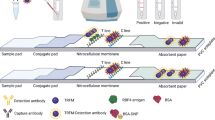Summary
Hematuria caused by prerenal, glomerular, postglomerular, and postrenal causes is usually differentiated by a number of noninvasive and invasive diagnostic procedures. In the present study we have applied a new analytical strategy based on observations that the various forms of hematuria can be classified by their typical protein pattern. When analyzed by quantitative turbidimetric assays, urines from postrenal hematurias contained high-molecular-weight proteins (α 2-macroglobulin and IgG) in proportions found in plasma. Relating excretion rates (mg/mg) of these proteins to those of albumin, ratios forα 2-macroglobulin/albumin and IgG/albumin were 2.0−31×10−2 and 20.0 –180×10−2, respectively. In contrast, glomerular hematurias exhibited ratios of 0.01−2.0×10−2 (α 2macroglobulin/albumin) and 2.0−20×10−2 (IgG/albumin). Additional determination ofα 1-microglobulin allowed us to differentiate postglomerular hematurias caused by interstitial nephropathies from glomerular and postrenal diseases. Critical evaluation of 93 cases diagnosed by independent clinical examination including histology, sonography, and cystoscopy revealed that the criteria derived from protein measurements resulted in correct classification when urine albumin exceeds 100 mg/l. This noninvasive procedure is expected to be of considerable help in the primary care of patients with unexplained hematuria.
Similar content being viewed by others
References
Birch DF, Fairley KF (1979) Haematuria: glomerular or nonglomerular? Lancet 11:845–846
Edel HH (1989) Asymptomatische Mikrohämaturie: diagnostischer Stufenplan. In: Verhandlungen der Deutschen Gesellschaft für Innere Medizin. Springer, Berlin Heidelberg New York, Band 95:531–537
Schütz E, Schaefer RM, Heidbreder E, Heidland A (1985) Effect of diuresis on urinary erythrocyte morphology in glomerulonephritis. Klin Wochenschr 63:575–577
Hofmann W, Guder WG (1989) A diagnostic programme for quantitative analysis of proteinuria. J Clin Chem Clin Biochem 27:589–600
Hofmann W, Guder WG (1989) Moderne Methoden zur Proteindifferenzierung im Urin. Lab Med 13:336–344
Hummel E, Carstensen H, Skott P, Larsen S, Parving HHAF (1987) Prevalence and causes of microscopic haematuria in type l (insulin-dependent) diabetic patients with persistent proteinuria. Diabetologia 30(8): 627–630
Kutter D (1983) Sind Teststreifenmethoden zum Blutnachweis im Urin zu empfindlich? Fortschr Urol Nephrol 21:11–16
Nagy J, Csermely L, Tovari E, Trinn C, Burger T (1985) Differentiation of glomerular and non-glomerular haematurias on basis of the morphology of urinary red blood cells. Acta Morphol Hung 33:157–160
Pillsworth TJ, Haver VM, Abrass CK, Delaney CJ (1987) Differentiation of renal from non-renal hematuria by microscopic examination of erythrocytes in urine. Clin Chem 33:1791–1795
Rizzoni G, Braggion F, Zacchello G (1983) Evaluation of glomerular and nonglomerular hematuria by phase-contrast microscopy. J Pediatr 103:370–374
Schiwara HW, Spiller A (1989) Differenzierung renaler und postrenaler Hämaturien und Proteinurien mit SDS-Polya-crylamidgel-Elektrophorese und Immunoblotting. Klin Wochenschr 67 [Suppl XVII]:14–18
Schramek P, Moritsch A, Haschkowitz H, Binder BR, Maier M (1989) In vitro generation of dysmorphic erythrocytes. Kidney Intern 36:72–77
Schurek J, Kühn K, Pagel H, Flohr H, Zeh M, Neumann KH, Alt J, Stolte H (1986) Untersuchungen zum Mechanismus der glomerulären Proteinurie. Nieren- und Hoch- druckkrankheiten 15:204–224
Thiel G, Bielmann D, Wegmann W, Brunner FP (1986) Glomeruläre Erythrozyten im Urin: Erkennung und Bedeutung. Schweiz Med Wschr 116:790–797
Venkat Raman G, Pead L, Lee HA, Maskell R (1986) A blind controlled trial of phase-contrast microscopy by two observers for evaluating the source of haematuria. Nephron 44:304–308
Wandel E, Marx M, Mayet W, Weber M, Köhler H (1988) Acanthocytes in glomerular hematuria — a typical urinary erythrocyte deformity. Kidney Intern 34:579–584
Author information
Authors and Affiliations
Rights and permissions
About this article
Cite this article
Hofmann, W., Schmidt, D., Guder, W.G. et al. Differentiation of hematuria by quantitative determination of urinary marker proteins. Klin Wochenschr 69, 68–75 (1991). https://doi.org/10.1007/BF01666819
Received:
Revised:
Accepted:
Issue Date:
DOI: https://doi.org/10.1007/BF01666819




